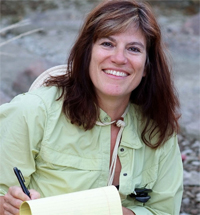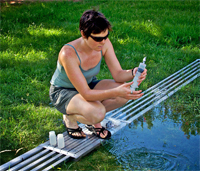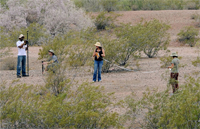August 31, 2009
Q&A with Nancy B. Grimm

Dr. Nancy B. Grimm

A CAP LTER student collects water samples in a stormwater retention basin

CAP LTER technicians and graduate students survey desert study plots
Dr. Nancy B. Grimm is Professor of Ecology, Evolution, and Environmental Science, affiliate faculty member in the School of Sustainability, and Co-Director of the Central Arizona—Phoenix Long-Term Ecological Research project (CAP LTER), an interdisciplinary study of the Phoenix metropolitan area.
When did you first incorporate the ideas of “sustainability” into your research?
I’ve been aware of sustainability’s relevance since the 1991 report, The Sustainable Biosphere Initiative, from the Ecological Society of America. Applying the concepts of sustainability, however, became directly relevant for my own research in 1998 when I began working in the field of urban ecology as principal investigator of the CAP LTER project. That made me consider how we can integrate the understandings of social sciences — human behaviors and actions — into ecological research.
What is your most important sustainability-related research project?
The CAP LTER project takes a long perspective on understanding human–ecological interactions in the Phoenix metro area. We study land change, climate, ecosystem structure and function, water, biodiversity, and material inputs, outputs, and transformations. Cities are prime ground for sustainability research: they are where most people live, and where both problems and potential solutions are concentrated. The key to finding urban solutions is they must be based in sound ecological principles or they won’t prove to be sustainable.
How can your sustainability-related research affect policy?
I want to help decision-makers and planners incorporate an ecological perspective into the design and construction of urban landscapes. For example, we know it’s a challenge to handle stormwater runoff in urban environments that have impervious surfaces and dramatically altered stream channels. Why not design ecologically sound ideas into the system such as nutrient removal, sediment trapping, and groundwater infiltration that have been successful in other regions? This is a conversation that must take place.
What is the world sustainability challenge that concerns you most?
In the long run, I am most concerned about climate change — not just warming, but the severe climate and weather events it will cause such as drought, floods, sea-level rise, and storm surges. These will pose significant threats to people who live where risk is greatest, mainly in cities.
How is your message getting out?
Science magazine published my ideas on the role of urbanization in global environmental change in a special issue on cities released Feb. 8, 2008. I also coordinated the society chapter in the U.S. Global Change Research Program’s synthesis book, Global Climate Change Impacts in the United States, which was jointly released by the White House and has been described as the most comprehensive report to date on the possible impacts of climate change across America and the policy choices we face.
August 31, 2009

